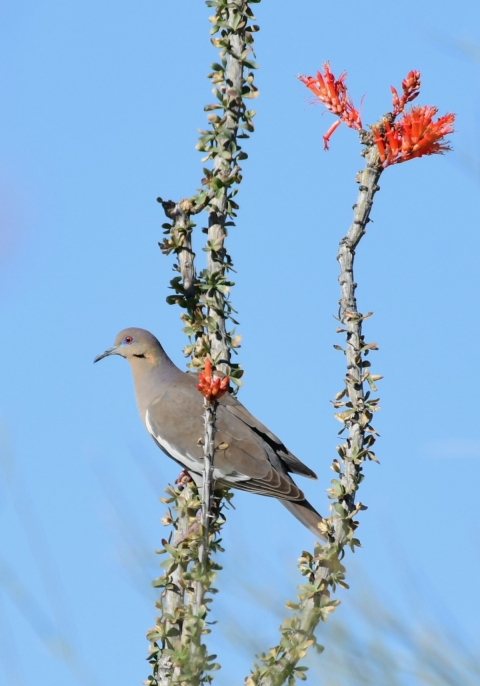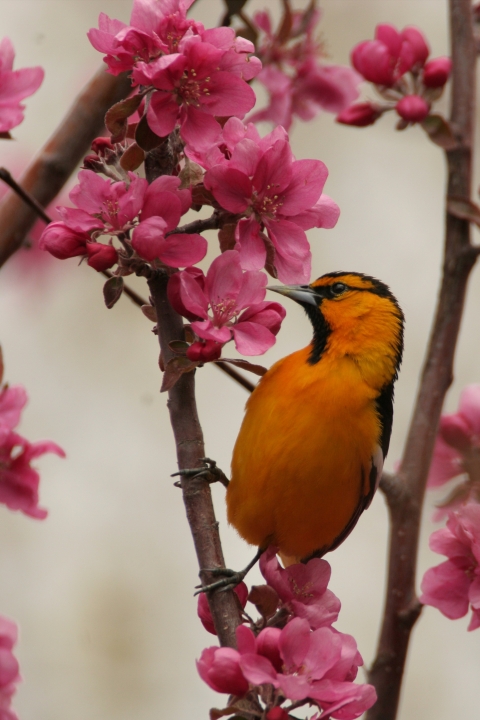From the charismatic hummingbirds of the continental United States to honeycreepers of the Hawaiian Islands and doves in the desert, a diverse array of bird species play an important role in pollination. Pollination is the process of transferring pollen from one flower to another, enabling plants to reproduce. While bees and butterflies often steal the spotlight, it’s essential to recognize that birds also play a role in this crucial ecological process!
When pollination is carried out by birds, it is called "Ornithophily." Like bees, many bird species visit flowers in search of nectar, a sweet liquid they use as a food source. As birds feed on nectar, pollen from the flower sticks to their bodies. When they move to another flower, some of the pollen rubs off onto the flower's stigma, the part that receives pollen, allowing fertilization to occur. In this way, birds help plants create seeds and produce new generations of plants. Some plants are specialized for pollination by opportunistic birds, while others have coevolved with specific bird species, or specialist birds. Some bird species have unique traits that make them effective pollinators, such as long, curved bills that reach deep into flowers and the ability to hover in mid-air.
By aiding in pollination, birds help to maintain the beauty and diversity of plant life around the world. In the United States, there are several bird species that actively contribute to pollination. Let's explore four of these remarkable pollinators:
'I'iwi (Drepanis coccinea)
‘I’iwi, or scarlet honeycreeper, are endemic to the Hawai’ian islands, specifically on the islands of Hawai’i, Maui, and Kauai, although some may still be found on Oahu and Molokai. These vibrant forest birds hold great significance in Native Hawaiian cultural heritage and play an important role in pollination to native Hawaiian plants like hāhā (Cyanea spp.), ʻōhāwai (Clermontia spp.), and especially, the state tree of Hawai’I, ʻōhiʻa (Metrosideros polymorpha). ʻOhiʻa lehua is also the host tree for this species, where they use the flowers to forage for nectar and the branches to build their nests. ‘I’iwi’s distinct long, curved red bills are perfectly adapted for sipping nectar from the tubular flowers of these plants. As they feed, they collect and distribute pollen. While ‘I’iwi are currently listed as a threatened species under the Endangered Species Act, designation of critical habitat, such as within Hakalau Forest National Wildlife Refuge, will help conserve this species and other Hawaiian wildlife.
Ruby-Throated Hummingbird (Archilochus colubris)
The ruby-throated hummingbird is a small but vibrant bird, known for their emerald-green feathers and brilliant red throat patch on the males. With their long, slender bill, hummingbirds feed on the nectar of brightly colored tubular flowers, picking up and transferring pollen as they quickly move from bloom to bloom. They forage while hovering in the air, eating frequently to power those tiny hearts that pump 1,200 times per minute and wings that beat 70 times each second! Like many hummingbird species, ruby-throated hummingbirds can visit upwards of 2,000 flowers per day. In comparison, most bee species generally visit around 1,500 flowers per day. Some hummingbird favorites include native wildflowers such as trumpet honeysuckle (Lonicera sempervirens), scarlet beebalm (Monarda didyma), lemon beebalm (Monarda citriodora), wild bergamot (Monarda fisulosa), cardinal flower (Lobelia cardinalis), and trumpet creeper (Campsis radicans). Ruby-throated hummingbirds are the only hummingbird species found throughout the Eastern half of the United States and into parts of Canada. More on hummingbirds here: Hummingbirds of North America
White-Winged Dove (Zenaida asiatica)
The desert-dwelling white-winged dove, found in the southwestern United States, is an important pollinator of the iconic Sonoran Desert saguaro cactus. These doves synchronize their migration with the flowering cycle of the saguaro, sipping nectar from its flowers and facilitating pollination. They not only help the desert bloom, but they also serve as the main seed predators of saguaros, aiding in dispersing the cactus's seeds as they nest in large trees that serve as nurse plants for saguaro seedlings, contributing even more to the plant’s survival. While white-winged doves are a notable pollinator of the desert, they are also found in a variety of other habitats, including native brushlands in Texas, farmlands, suburbs, and open oak woods.
Orioles
Of the eight New World oriole species occurring in the United States, the Bullock's oriole, orchard oriole and the Baltimore oriole are most commonly associated with pollination due to their rather messy nectar-feeding habits! Their cross-pollination of plants is a happy accident that leads to the fertilization of flowers and the production of seeds. While in their tropical winter habitats, they eat nectar from flowering trees and transfer pollen from tree to tree, which helps pollinate many tree species. When they return to North America in the spring, they are attracted to nectar feeders and continue to pollinate flowering plants. Unlike hummingbirds, orioles have short beaks and become covered in the sticky flower pollen on their body, like a bumblebee! While they primarily eat insects in the summer months, they switch to eating fruit in the fall, often preferring dark-colored fruits such as native wild black cherries and blackberries.
These species, along with many other pollinating bird species around the world, exemplify the critical role that birds can play in maintaining ecological balance and diversity of plant life. Their interactions with plants not only benefit biodiversity but also highlight the interconnectedness of nature, where birds and plants rely on each other for mutual sustenance and survival.
To learn more about pollinators, check out the Service's Center for Pollinator Conservation











